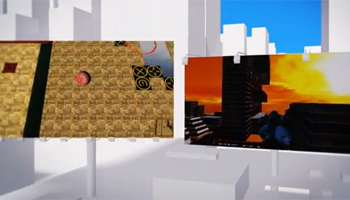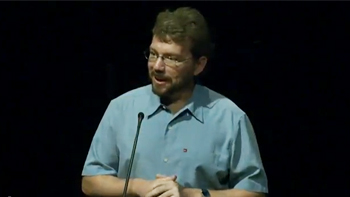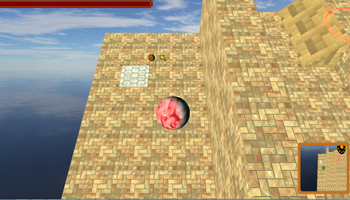In Hot Computer Science Course, Students Build 3D, Multiplayer, Networked Games
By:
- Doug Ramsey
Published Date
By:
- Doug Ramsey
Share This:
Article Content

Still frame from opening sequence of a new video produced by Calit2 to highlight CSE 125, a software design and implementation course for seniors who develop 3D, real-time, networked games. Click here to watch the video. Video presentations from the spring 2012 course are available here.
An early March deadline is fast approaching for University of California, San Diego students who want to take one of the hottest courses on campus – and one of the most competitive, with only 30 slots each spring.
The course, Computer Science and Engineering 125, will also dazzle high-school students who descend on the UC San Diego campus on April 6 for Triton Day, with their admission letters in hand. The CSE department will showcase what sets the UCSD program apart from computer science at other top-notch universities, and that will include showing a freshly-minted video about last spring’s course.
CSE 125 has a seemingly innocuous title – “Software System Design and Implementation” – but most Jacobs School of Engineering students know it as “the video game course.”
Recent graduate Lex Lacson, who is now at Sony, says he knew all along that he wanted to take the course. “I have been planning to take this course ever since I started my CSE major,” said Lacson, who took CSE 125 last spring, when he helped developed the game Sever, a third-person, flight combat, tug-of-war action game. “I wanted to take it because it seemed really exciting and I wanted… an opportunity to do something extraordinary.”
“I heard about it my sophomore year when I switched to computer science,” recalled Matthew Religioso, who worked on the Sever team with Lacson and is now a game developer. “Ever since then I tried to plan out my schedule so I could take it my senior year. It was probably the most time-consuming course I have ever taken, but it was well worth it.”
That is music to the ears of Jacobs School professor Geoffrey M. Voelker, who introduced the course in 2001 and still teaches it every spring. He says that CSE 125 offers students the chance to demonstrate much of what they learned in the previous three years – in the form of something that is easily understood by friends, family members, and potential employers.

CSE 125 professor Geoffrey Volker sums up the spring 2012 course before the student teams demonstrated their games.
“To make the class exciting as well as challenging, the project is a 3D multiplayer game of each group's own design,” said Voelker. “From my perspective, I want them to experience designing and implementing a large-scale, distributed system, and to make it fun and interesting for them – it’s a real-time, networked game that the students can get really excited about.”
Students experience the design and implementation of a large, complex software system in teams of six, seven or even eight students, who usually split up into sub-teams to develop 3D graphics and sound, networking, the server, and models and animations. Emphasis is placed on the development process in addition to the final product. Over the course of 10 weeks, the groups decide on the features of their project, specify its requirements, create a design and implementation schedule, implement it, and give a public demonstration at the end of the quarter that takes the place of a final exam.
The large times are designed to equip students for working on a software development team in industry. “No one person can do all of the project, so you have to work together to be successful and you have to learn how to cooperate, communicate, and collaborate with other people,” said Voelker. “To be successful, there is no one person who says, ‘we're going to do it this way.’ Everybody is going to have to do it.”
Most students take CSE 125 in their final quarter before graduating, when they might otherwise feel free to slack off. But not all of these students.
“We started over spring break and we basically made the lab our home and lived down there and planned to spend all of our days, nights, and weekends working on the game,” explained Alex Ferbrache, a rare junior on the 2012 team that developed the pirate-themed Broadsides game. “I think it was worth it, because everything we did was something that we made, that we created.” Ferbrache hopes to work in the industry when he graduates in 2013.
“Anything worth doing is worth putting in a lot of effort for, and I think 125 is definitely one of those things,” said David Dawson. “You have to be a good team player and put in the effort that's required. So I think there is a lot to be gained from this course.” Dawson parlayed his skills in team engineering on the game Sever into a job in San Diego as a software development engineer at Amazon.

The 2012 game HectiKinetic featured game play to achieve a goal by cooperating with a teammate.
“They don't need to do this at all, but they're so passionate and committed about their projects that they still put in this time – more time than perhaps any other course they have ever taken,” noted Voelker. “What's incredible is that they go from just design ideas to a fully working game at the end of the quarter, when they can get up on a stage in front of an audience of 200 people and have people from the audience come up and play the game and demo it for 15 minutes to show it off.”
“Once you realize you have a playable game and it actually works, it really makes you feel fulfilled,” said Corey Mangosing, a computer engineering student who graduated in 2012 and did graphics on The Kings of Kohmaydie, a tactical, real-time, strategy game played on an isometric grid.
Not surprisingly, the excitement of completing a massively multiplayer online game in just 10 weeks leads some students to consider working in the industry full-time: “I have always wanted to work with games,” said Joey Ly, who co-developed the game Charged in 2012, an arena-based, free-for-all with robots. “It's always been in the back of my mind.”
According to Voelker, as many as 10 percent of the students enrolled in CSE 125 each spring end up going into the games industry, and many of them get to stay in San Diego, which has become a magnet for companies in the industry. Course alumni have gone to work for a long list of companies, including Blizzard, Sony Online Entertainment, Pixar, Rockstar San Diego, Havok, Rhythm & Hues, Microsoft’s DirectX group, and many more.
“This class makes you marketable,” said Alex Goldberg, who took CSE 125 in 2007, then went to work for PixelActive. “This class has you leaving UCSD with a portfolio and something awesome that you can send to someone, that you can prop up on a laptop or iPad, and show something that really just takes people's breath away.” PixelActive was acquired by Nokia, but Goldberg still applies video game practices and technologies to the mapping and navigation of spaces for smart phones.
Alfred Tang and Ryan Mourney are two members of the Class of 2012 who went directly from earning a degree to working in the games industry – Tang at Sony Online Entertainment, Mourney at Blizzard Entertainment. “I've got a job lined up at Blizzard, so I am going to have a lot of fun with that,” said Mourney prior to graduation. “I am going to start out server programming for their next-generation MMO [massively multiplayer online] team.”
Reports and videos of the final demonstrations of the 2012 games can be accessed online at cse125.ucsd.edu/cse125/2012/groups.html. For a course overview, including further instructions on how to apply for the course, visit cse125.ucsd.edu/cse125/2013/overview.html. And to watch the new video about CSE 125, click on the video link at the top of this release, or view it on YouTube at youtube.com/watch?v=LYOy2f1yfXU.
Share This:
You May Also Like
UC San Diego is Strengthening U.S. Semiconductor Innovation and Workforce Development
Technology & EngineeringStay in the Know
Keep up with all the latest from UC San Diego. Subscribe to the newsletter today.



